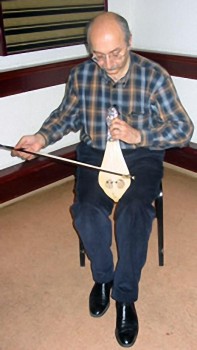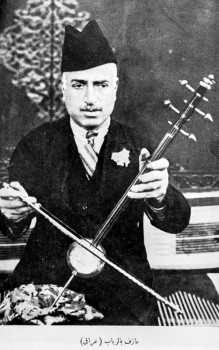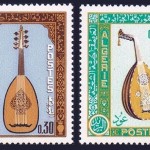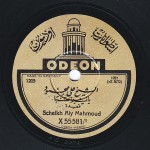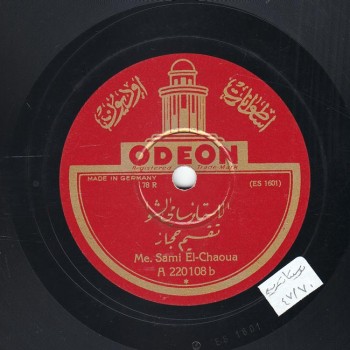 The Arab Music Archiving and Research foundation (AMAR), in collaboration with the Sharjah Art Foundation (SAF), presents “Niẓāmunā al-Mūsīqī”.
The Arab Music Archiving and Research foundation (AMAR), in collaboration with the Sharjah Art Foundation (SAF), presents “Niẓāmunā al-Mūsīqī”.
Dear listeners,
Welcome to a new episode of “Niẓāmunā al-Mūsīqī”.
Today, we will be resuming with Mr Mustafa Said our discussion about taqsīm-s (modal improvisation) and a practical way to master and produce good taqsīm-s.
I have noticed that you are applying the Divide and Conquer strategy that consists in transforming something complicated into parts that are gradually simpler, which you define as “minimalist”, and then starting to build from the smallest, complicating the elements until you reach a more mature shape, i.e. from small, to bigger, to taqsīm-s, to everything deriving from taqsīm-s.
Well…
I am amazed at this manner, and you should be thanked for it.
You are welcome… But this is just how it is… I haven’t invented anything… it is a cultural heritage.
That said, is this clear among the major instrumentalists who play our heritage and our system in this manner? Do you feel that they produce the same taqsīm-s with the same measures and the same taf‘īla-s (trochee-s)?
To my knowledge, they knew this, as illustrated in Sāmī al-Shawwā’s book “Al-qawā‘id al-fanniyya” (The Artistic Rules), by Ṣafī al-Dīn al-Urmawī’s words seven hundred years before him, in Turkey by Dimitrie Cantemir’s words, even in Muḥammad Shahāb al-Dīn’s ”Safīnat al-Mulk wa-nafīsat al-fulk”, knowing that the latter was not even specialised in music.
So it was practised.
Yes… they knew it.
This is why you consider that qisma (segmentation. cadence) is derived from the infinitive qasama (cut. segment).
Yes.
Even the book “Kitāb al-aghānī” states that “The accomplished muṭrib (singer) is the one who masters the segmentation of the melody in accordance with the lyrics and the measure in the voice”. Abū al-Ḥasan al-Ṭaḥḥān said “The accomplished instrumentalist is the one who can accompany the muṭrib through the segmentation of the melody as if he were singing with his instrument”… All this is mentioned in books. They were aware of this and were able to express it in either a scientific or non-scientific way… I do not know and it does not matter. The point is that this concept existed within their practice.
Life is all about receiving and relaying: you receive and you relay to those who follow.
Now, about playing a recording and noting these taf‘īla-s… Are they, along with these practices, easily noticed in heritage recordings?
Let us listen to a taqsīma by Sāmī al-Shawwā and find out if you will notice the taf‘īla-s or not.
Excellent …
(♩) (Sāmī al-Shawwā – Taqsīm ḥijāz)
Do you think that there are other good ways to learn taqsīm, such as learning through initiation, or learning through a phrase played by the murshid (guide. teacher. mentor) v/s a phrase played by the murīd (follower. pupil. disciple), each answering the other and continuing, or other ways?
I can’t say if a learning method is good or bad. At the end of the day, the result heard will settle it.
Throughout your experience, or by hearsay, do you know about people who have learned by initiation or memorisation?
I have noticed that those who are aware of the issue of taf‘īla-s, in a way or another, produce more innovative phrases than those who memorise taqsīm-s, or those who are not aware of the relation between music and language, or do not consider music itself as a linguistic system.
Based on this, is it possible to notice the differences between Turkish, Egyptian, Iraqi, and Azerbaijani taqsīm-s?
The differences between the dialects may have led to the differences between playing dialects: At the end of the day, all the civilisations you have mentioned follow one melodic system, regardless of those who claim to be unique. Even if the theories are different, practice demonstrates that it is one melodic system.
The differences lie in the dialect: Arabic spoken in the Arabian Maghrib is totally different as to the pressures and dialect from the Arabic spoken in the Arabian Peninsula, in the Levant, in Egypt, or in Iraq. The dialects differ between neighbouring countries… Arabic spoken in the East of the Arabian Maghrib is closer to Egyptian, Sinai Egyptian Arabic is closer to Levantine Arabic, Dayr al-Zōr Arabic is closer to the Iraqi dialect… etc. There is overlapping among the dialects that all belong to the same language …
(♩) (Rabāba (bowed string instrument) – Morocco, Jawza (Iraqi rabāba) – Ṣāliḥ Shumayl – Iraq , Rabāba – Turkey – Fikrat Karkāy).
Music is more universal: with a little training, any Egyptian could play with any Iranian, Turk, or Azerbaijani.
For the unity of the maqām system.
It is the same system.
Could you play for us taqsīm-s that relax the brain, the mind, and the spirit?
Which maqām do you prefer?
It does not matter …
(♩) (Taqsīm by Mustafa Said)
Dear listeners,
We have reached the end of today’s episode of “Niẓāmunā al-Mūsīqī” presented to you by Fadil al-Turki and Mr Mustafa Said.
We will meet again soon.
“Niẓāmunā al-Mūsīqī” is brought to you by Mustafa Said.
- 221 – Zakariyya Ahmed – 12 (1/9/2022)
- 220 – Zakariyya Ahmed – 11 (1/9/2022)
- 219 – Zakariyya Ahmed – 10 (11/25/2021)
- 218 – Zakariyya Ahmed – 9 (10/26/2021)
- 217 – Zakariyya Ahmed – 8 (9/24/2021)
- 216 – Zakariyya Ahmed – 7 (9/4/2021)
- 215 – Zakariyya Ahmed – 6 (8/28/2021)
- 214 – Zakariyya Ahmed – 5 (8/6/2021)
- 213 – Zakariyya Ahmed – 4 (6/26/2021)
- 212 – Zakariyya Ahmed – 3 (5/27/2021)
- 211 – Zakariyya Ahmed – 2 (5/1/2021)
- 210 – Zakariyya Ahmed – 1 (4/28/2021)
- 209 – W-al-Lāhi lā astaṭī‘u ṣaddak 2 (4/6/2017)
- 208 – W-al-Lāhi lā astaṭī‘u ṣaddak 1 (3/30/2017)
- 207 – Bashraf qarah baṭāq 7 (3/23/2017)

